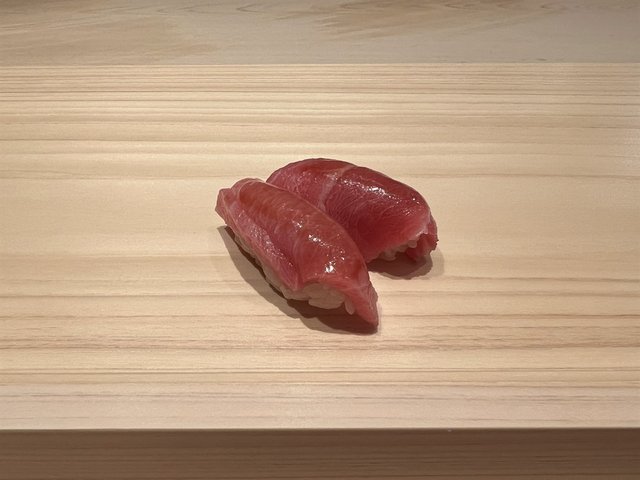Read full review
2021-12-20
4305 views
This Japanese sushi restaurant has been awarded Michelin 1-star, headed by the famous Mitsuhiro Araki, the only Japanese chef who had achieved Michelin 3-star in both Tokyo and London. Located in the heritage building of FWD House 1881 in TST, fortunately it is still comparatively easy to reserve, compared with some of the other famous sushi restaurants in town. Coming on this Friday evening, we arrived sharp at 6pm. On the side wing of the heritage building, the entrance was simple but you cann

This Japanese sushi restaurant has been awarded Michelin 1-star, headed by the famous Mitsuhiro Araki, the only Japanese chef who had achieved Michelin 3-star in both Tokyo and London. Located in the heritage building of FWD House 1881 in TST, fortunately it is still comparatively easy to reserve, compared with some of the other famous sushi restaurants in town.

Coming on this Friday evening, we arrived sharp at 6pm. On the side wing of the heritage building, the entrance was simple but you cannot miss it because of the big Michelin award plaque, and the staff is stationed to welcome the guests.

The décor is simple and familiar, with the L-shaped solid wood sushi counter hosting a total of 10 seats. It was a bit of a disappointment as we were seated at the far end, so we could only see how the chefs prepared the food from the side behind their backs.

Having pre-paid for the Omakase Menu ($4,000 each), I ordered a bottle of sake to pair with the food. The Masuizumi Ryu’s Daiginjo 満寿泉 大吟醸 寿 ($2,800) is made by 桝田酒造店 in Toyama under the name of the restaurant, with a golden dragon on the label, a pretty sake with a nice sweet note that paired very well with the food.

The first course was Abalone, from Miyagi Prefecture. The chef first steamed the abalone and then braised in stock, together with the same type of rice for the sushi, to make it very soft and tender. It was then brushed with some Chinese yellow wine. The chef removed the mouth of the abalone, then remove also the liver, before cutting the abalone into slices. Chef Araki then personally plated the dish. The abalone had a great texture, with its original taste seeping out from the bite. The liver had a bit of earthy note and was a good complement. It was really tasty.

The second course was Steamed Parrot Fish. The rare fish was line-caught by local fisherman at South China Sea, near Poi Toi Island. After steaming with kombu, dried herbs, sake and some spring onion, the chef then poured on top some dashi sauce mixed with egg white. The fish had a great firm texture, with delicate flavours which was exemplified by the umami notes of the dashi sauce. The soft egg white added a touch of silkiness on contrast to the fish. It was so good I ended up scooping the last drop of sauce at the end.

The third course was Hirame Sashimi. The olive flounder was locally caught, then aged for one day on top of kombu, to bring out the umami taste. Chef Araki first sliced out thin pieces from the hirame fillet, and then he took the skirt, or engawa, and cut into pieces as well. Plating together with a bit of the fish roes, the sashimi was really good, with the hirame having its signature mild and slight sweet taste, firm and bouncy texture. The engawa had a crunchier bite, and the roes was a first-time experience for us, cooked with dashi and some soy sauce, also very delicious. The chef also prepared a special soy sauce to dip the sashimi, and overall, another amazing dish.
Coming to the sushi part of the meal. Before serving the chef told us the etiquette of eating sushi, emphasizing the importance of eating the sushi right after serving to enjoy them at the best temperature. He also shared how to eat with the fingers, using the three fingers to hold it up and then turning it upside down to put into the mouth, with the fish on the bottom touching the tongue.

With the sou chef having trimmed the Hokkaido tuna fillet earlier, Chef Araki now meticulously cut out the different parts for the sushi. The first piece of sushi was Akami, the lean tuna. It was pure joy when swallowing the sushi, the texture of the tuna so soft and without any residue, with all tendon and fibrous part already removed. Heavenly delicious.

Next were two pieces of Chutoro. The chef reminded us to eat the right piece first and I asked why. In fact, the second piece was slightly fattier, so there was a progression in terms of taste. The chef also checked with us whether the size of the sushi would need to be adjusted in future pieces too. Again, the tuna was so soft and with the fat seeping out the intense flavours, they were true wonders indeed.

The trio could not be completed without Otoro, the fattiest part at the belly. Continuing on the journey, the two pieces were essentially melting in the mouth, with intensity of flavours truly exemplified the reason why many people regarded this as the best sushi, especially under such good hands like Chef Araki, who kept changing the rice to ensure they were about the body temperature for best enjoyment.

The sixth piece was Blackthroat Seaperch, or Akamutsu. This deep-sea fish came from Japan and after slightly grilled on charcoal, the chef served it onto our hands, as the texture was very soft that it would probably disintegrate if putting on the table for us to pick up by ourselves. The fish oil had been vitalized by grilling, and the chef also specially made the sushi rice a bit looser to pair with the fluffy texture of the fish. This showed the attention to details Chef Araki had on his sushi.

The seventh sushi was the local Bigfin Reef Squid, or Aori-ika, the highest quality squid regarded by the Japanese people. Very fresh, the chef had cut the squid in a great demonstration of knife skill, breaking all fibres so it was so soft, to the degree that I would say it was velvety on texture. One of the best squid sushi I had tasted for sure.

The eighth piece was another local fish, seasonal White Sea Bream. Another great sushi, with the rich sweet taste of the sea bream fusing with the sushi rice to offer a harmonious and delightful experience. The quality of this fish was very good and would not be inferior to those flying in from Japan in my opinion. The sou chef secretly told us where the fish was purchased too.

Then the chef brought us a plate with the Tentacles of the Bigfin Reef Squid. After grilling on charcoal, it was sprinkled with some Japanese chili powder and soy sauce. The texture was firmer than the sushi, with good bite and definitely a wonderful dish to pair with beer or sake.

The ninth sushi was Mackerel, or Saba. The chef had cut the fish into small cubes, and then mixed with some sesame and ginger, before kneading it to form the sushi. It also needed to serve to the hand as a result. Added with a bit of spring onion on top, the mackerel had its intense flavours but not in any way fishy, with the fragrance of the sesame and ginger balancing perfectly. One of my favourite sushi on the night.

The tenth piece was Marinated Lean Tuna, or Akami Zuke. This style was a traditional method to preserve the fish, when refrigeration was not common. The chef had put the tuna in soy sauce and rice vinegar to marinate for a short while, taking them out at the right moment. The texture was very soft, with the marinade adding another layer of flavours.

The eleventh sushi was Large Clam from Cheung Chau, or Hama-guri. A common seafood found in Tokyo Bay in the Edo Period, the clam meat was first removed from the shell, then cooked with soy sauce and sake, before marinating for a few days and then made into sushi. The sweetness and umami of the clam was not lost but in fact enhanced in the process.

The twelfth piece was Sea Urchin Gunkan, with the chef using Hokkaido Bafun-uni. The seaweed was very crisp, contrasting with the silky texture of the sea urchin, a perfect match. The signature taste of this type of sea urchin, bolder in flavours and slightly more bitter, was not our most preferred choice of sea urchin, but it was still a very good one.

The thirteenth sushi was another piece of Otoro, but this one had been seared. With the fish oil bursting out when biting in, the flavours were so intense that it completely covered and overpowered our palate, a very rewarding and fulfilling experience. Even my wife, who was not a fan of Otoro, could not suppress her praise on how tasty it was.

Nearing the end, the fourteenth piece was local White Eel, which had been kept in the tank for at least three days so the eels would be rid of the muddy taste. After steaming and grilling them, the chef carefully chopped the eels so that any small bones were all broken down, before brushing some special sauce on top before serving. Feeling like soft silk which dissolved in the mouth, it was another nice one.

The last piece was Egg Roll, or Tamagoyaki. The traditional final dish in edomae sushi, the chef had used prawn, sea bream and abalone to mash into a fine paste using a mortar, then slowly adding the egg, Japanese mountain yam, sake and mirin, and some local honey. Normally they were cooked in a square pan and made to a rectangular shape, but Chef Araki had followed how his master had taught him to prepare it in a roll, showing the Japanese character ‘の’ , representing the complete and finale of the meal. The egg roll was spongy and slightly sweet, having plenty of umami too from the seafood.

The chef then asked whether we were still hungry, and despite quite full, we added the signature Tuna Hand Roll ($400 each). Chef Araki took out the big piece of tuna from the fridge, and then cut out a good portion, before preparing the hand roll with the seaweed. With a generous amount of tuna, this was the best-ever hand roll I had. The price might seem a bit high, but it was definitely worth trying it out.
Overall, the service was very good, with all the chefs and the staff friendly, happy to explain all the dishes in great details, sharing the ingredients throughout, and answering our questions. Even with his fame, Chef Araki had handled a lot of the preparation and made all the sushi himself, and when we were leaving, he and his whole team came to the door to see us off. Even though it was the most expensive sushi restaurant in town with the meal costing $12,857 I would recommend it to anyone who wanted an amazing sushi experience.
Post
